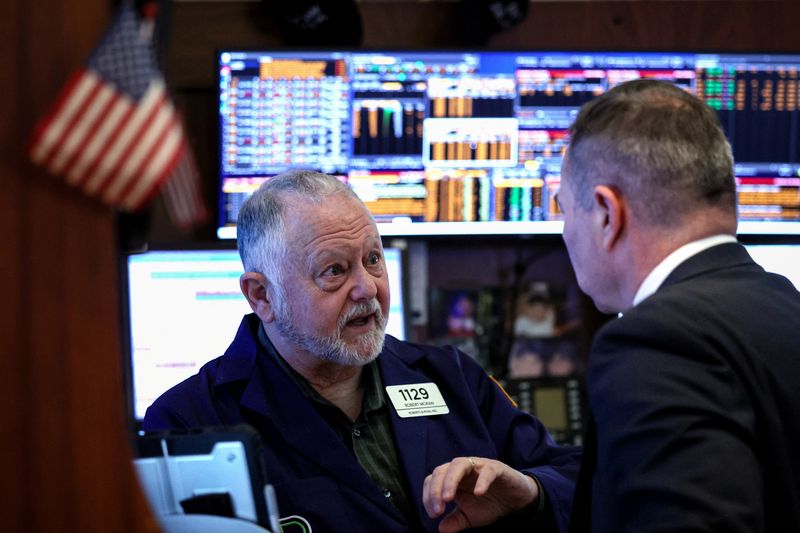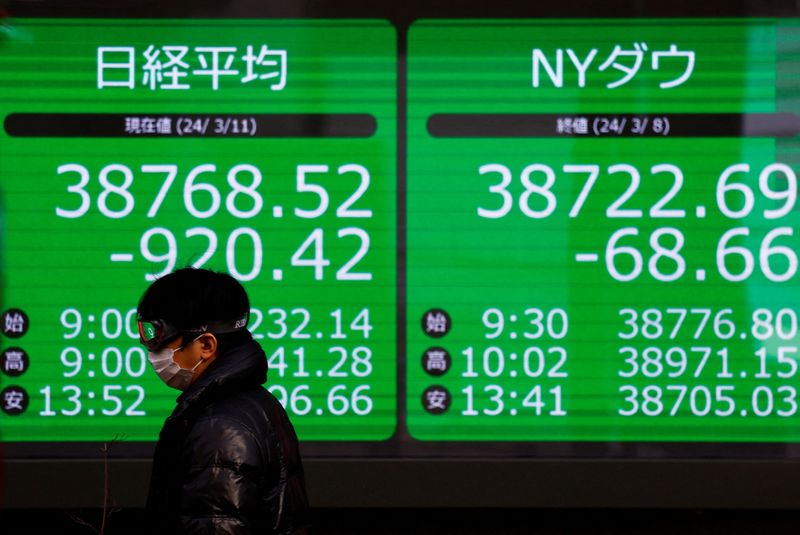By Koh Gui Qing and Alun John
NEW YORK/LONDON (Reuters) -Global shares edged higher and the yen slid past 150 to the dollar on Tuesday after the Bank of Japan met market expectations by ending eight years of negative interest rates, likely the highlight of a busy week for central banks.
Investors will now turn their focus to the U.S. Federal Reserve's monetary policy meeting that ends on Wednesday, when the central bank is expected to provide further clues about the pace at which it will likely lower interest rates this year.
Financial markets are now considering the chance that the Fed might reduce the number of projected rate cuts this year to two from three on the back of last week's stronger-than-expected inflation data.
"We don’t think the Fed will fundamentally change its outlook for inflation based on two hotter than desired prints to start the year," said Christopher Hodge, chief economist at Natxis CIB Americas.
"However, we do expect a slightly more hawkish tone in the hopes of keeping a leash on financial conditions."
MSCI's world share index was little changed, and hovered near all-time highs. Stocks on Wall Street reversed earlier losses, with the Dow Jones Industrial Average rising 0.83%, the S&P 500 gaining 0.56%, and the Nasdaq Composite adding 0.39%.
The U.S benchmark 10-year Treasury yield was down 4.8 basis points to 4.293%, from 4.34%. [.N] [US/]
The day's big news was in Japan, where the BOJ heralded a new era as it shifted away from years of ultra-easy monetary policy. It also abandoned bond yield curve control and dropped purchases of riskier assets, including exchange-traded funds.
Japan's Nikkei was choppy after the decision but closed 0.66% higher, buoyed by the weaker yen, while Japanese government bond yields fell. The dollar rose 1.15% to 150.88 yen against the Japanese yen.
"The BOJ clearly has been very, very keen to manage this process so that it is not disruptive,” said David Mitchinson, fund manager at Japan focused Zennor Asset Management. “The markets have front-run them and anticipated their move.”
Though the shift was Japan's first interest rate hike in 17 years, it still keeps its rates stuck around zero as a fragile economic recovery forces the central bank to go slow on further rises in borrowing costs, analysts say, giving the rate-sensitive yen little traction.
In a statement announcing its decision, the BOJ said it would keep buying "broadly the same amount" of government bonds as before.
"So some of that spread closure between Japan and the U.S. isn’t quite really happening at the moment because although Japan has hiked a little, the U.S. hasn’t cut,” said Mitchinson, pointing to the fact that U.S. inflation pressures have been stronger than expected.
BOJ Governor Kazuo Ueda said in his press conference that accommodative financial conditions would be maintained for the time being and the pace of further hikes would depend on the economic and inflation outlooks.
European shares were fairly muted, with the STOXX 600 and euro zone bond yields little changed. (EU) [GVD/EUR]
CENTRAL BANK BONANZA
In the day's other central bank news, the Reserve Bank of Australia held interest rates steady as expected, while watering down a tightening bias to say it was not ruling anything in or out on policy.
The Australian dollar slipped 0.42% to $0.6532 following the decision. The Aussie is down over 4% against the U.S. dollar this year.
The Federal Reserve's two-day meeting wraps up on Wednesday, and central banks in Britain, Norway, and Switzerland meet on Thursday. All are expected to keep rates steady, though markets are not ruling out a move in the Alps.
When it comes to the Fed, the market's attention is on policymakers’ updated economic and interest rate projections and comments from Chair Jerome Powell.
Last week's stronger than expected inflation reports led traders to reduce their bets on U.S. rate cuts this year, with markets now pricing in 71 bps of easing in 2024, roughly in line with expectations the Fed published in December, the latest iteration of which are due at this meeting.
At the start of the year, traders were pricing in 150 bps of cuts.

In commodities, spot gold dropped 0.1% to $2,158.00 an ounce, after hitting all time highs earlier this month. U.S. crude recently rose 0.85% to $83.42 per barrel and Brent was at $87.38, up 0.56% on the day. [O/R]
Bitcoin stayed in the red for the day and was down 5.91% at $63,616.00 by late afternoon in New York.
(Additional Reporting by Naomi Rovnick in London, Editing by Kim Coghill, Mark Potter, Chizu Nomiyama, William Maclean)
